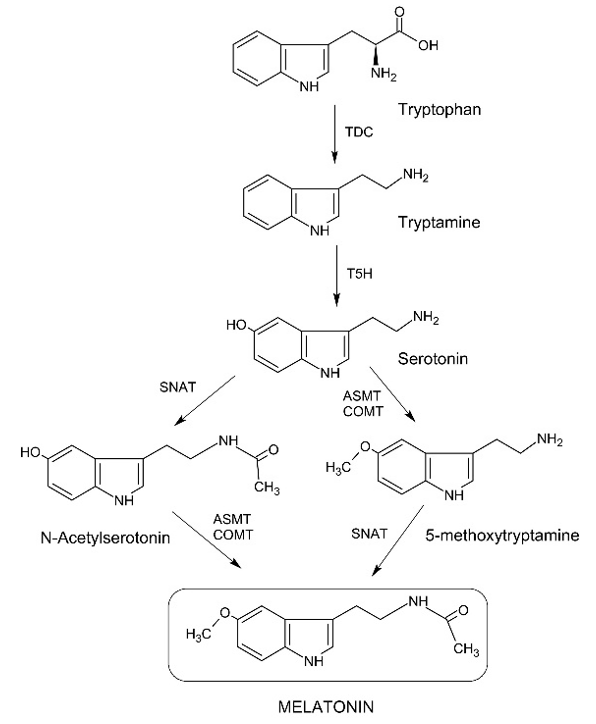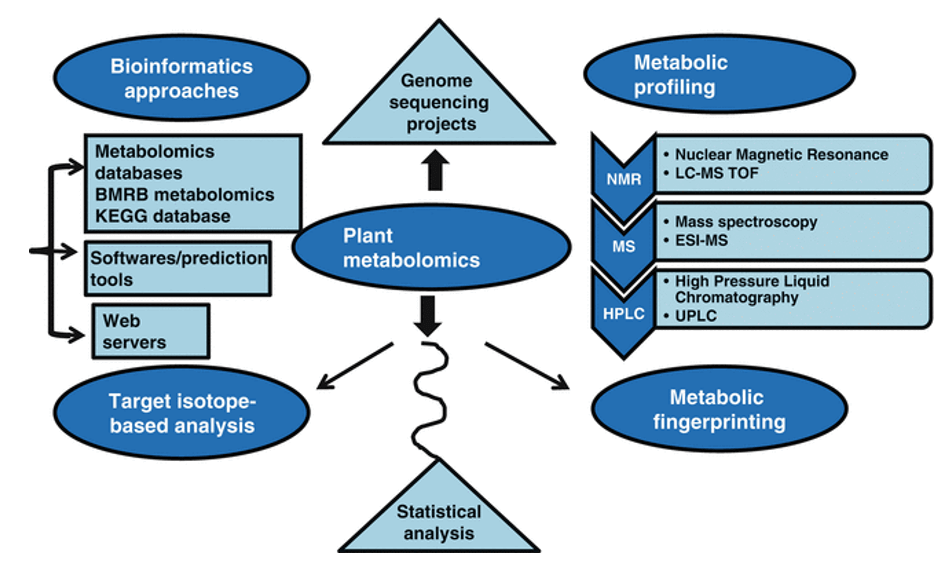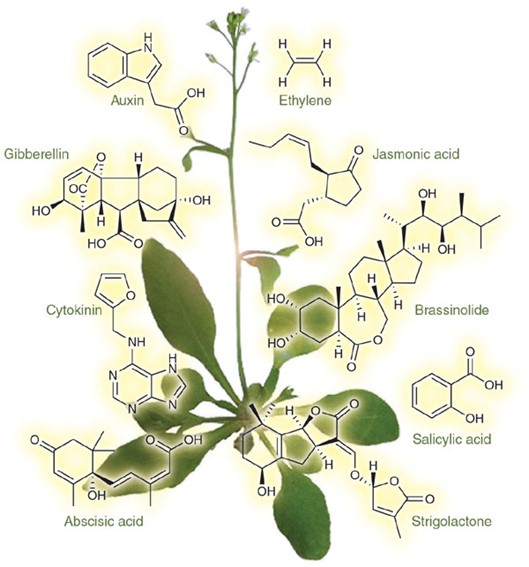Melatonin Analysis Service
Submit Your InquiryWhat is Melatonin?
Melatonin (N-acetyl-5-methoxy-tryptamin) is an indoleamine neurohormone that has been identified in more than 140 plant species in the past 20 years. Studies have shown that melatonin is implicated in almost all of the plant growth and development stages. Additionally, melatonin is reported to effectively protect plant tissues via responses to a variety of abiotic and biotic stresses, including drought, salt, cold, heat, and pathogen infection. Accurate and sensitive detection and quantification of endogenous melatonin enable us to better understand its physiological functions, biological synthesis, metabolic pathways, and regulatory networks. Ultra-performance liquid chromatography (UPLC) coupled with mass spectrometry (MS) has been proved as a reliable approach for analyzing melatonin content in plants because of its high sensitivity, reproducibility and accuracy.
Creative Proteomics offers a specialized melatonin quantification service. With a team of experienced scientists and cutting-edge equipment, Creative Proteomics ensures the delivery of high-quality and reproducible results. Whether you are conducting basic research, clinical studies, or drug development, our service provides valuable insights into melatonin dynamics.
 Figure 1. MTsynthesis pathway (Arnao & Hernández‐Ruiz 2020).
Figure 1. MTsynthesis pathway (Arnao & Hernández‐Ruiz 2020).
Applications of Melatonin Analysis
Plant Growth and Development: Investigating melatonin's influence on growth stages in plants.
Biosynthesis and Metabolic Pathways: Unraveling the mechanisms of melatonin production in plants and metabolic pathways.
Signal Transduction and Regulatory Networks: Understanding melatonin signals within plants and regulatory networks affecting gene expression.
Sustainable Agriculture: Exploring applications to enhance crop yield, stress resistance, and overall plant health.
Abiotic Stress Responses: Assessing melatonin's role in fortifying plants against stressors like drought, salinity, and extreme temperatures.
Antioxidant Properties: Studying melatonin's antioxidant capabilities to mitigate oxidative stress in plants.
Crop Quality Enhancement: Evaluating the potential of melatonin to improve crop quality, flavor, and post-harvest shelf life.
Disease Resistance: Investigating melatonin's impact on plant immunity to reduce the need for pesticides.
Regulation of Secondary Metabolites: Exploring melatonin's influence on secondary metabolites in plants for medicinal and nutritional purposes.
Environmental Adaptation: Understanding melatonin's role in helping plants and animals adapt to changing environmental conditions.
Circadian Rhythm Regulation: Influencing sleep-wake cycles in both humans and animals.
Neurological Health: Investigating melatonin's neuroprotective properties and impact on neurological processes.
Aging and Age-Related Diseases: Exploring the correlation between melatonin levels and aging
Psychiatric Disorders: Studying links between melatonin and psychiatric disorders.
Endocrine System: Investigating interactions between melatonin and the endocrine system in various species.
Pharmacological Research: Assessing the efficacy of melatonin-based therapies and understanding pharmacokinetics.
Advantages of Our Melatonin Analysis Service
Workflow of Melatonin Analysis
Creative Proteomics offers a highly sensitive and selective method for detecting and quantifying melatonin in plants using UPLC-MS/MS. We are experienced in dealing with a variety of sample types, and achieve high sensitivity and specificity due to reduced background noise, without homogeneity between samples.

Quantitation method: external standard method
Melatonin Analysis Content
Melatonin Identification by Mass Spectrometry: Accurate identification of melatonin and its related compounds through mass spectrometry techniques, ensuring precise characterization.
Quantitative Analysis of Melatonin Levels: Precise measurement of melatonin concentrations in biological samples using advanced mass spectrometry methods, such as LC-MS or GC-MS.
Structural Elucidation of Melatonin Metabolites: In-depth analysis of melatonin metabolites, including the elucidation of their structures, to understand the metabolic pathways and transformations.
Melatonin Isotopic Labeling Studies: Utilization of isotopic labeling techniques for studying melatonin metabolism and turnover, providing valuable kinetic information.
Melatonin Fragmentation Analysis: Examination of melatonin fragmentation patterns under different conditions to aid in the identification and structural characterization of melatonin and its derivatives.
Melatonin-Protein Interaction Studies: Investigation of melatonin binding to proteins using mass spectrometry-based techniques, offering insights into its interactions with biological macromolecules.
Melatonin Profiling in Biological Matrices: Profiling the distribution of melatonin and its metabolites in various biological matrices to understand their tissue-specific concentrations.
Custom Melatonin Mass Spectrometry Services: Tailored projects to address specific research questions or meet unique analytical requirements related to melatonin, providing a flexible and personalized approach.
Sample Requirements for Melatonin Analysis
| Sample Type | Sample Volume | Pre-treatment Requirements |
|---|---|---|
| Whole Blood | 0.5 - 1 mL | Anticoagulants (e.g., EDTA, heparin) |
| Serum | 0.5 - 1 mL | Centrifugation, Protein Precipitation, or Solid-Phase Extraction |
| Plasma | 0.5 - 1 mL | Centrifugation, Protein Precipitation, or Solid-Phase Extraction |
| RBCs (Red Blood Cells) | Variable | Centrifugation, removal of plasma and buffy coat |
| Urine | 1 - 2 mL | Filtration or Centrifugation |
| Saliva | 0.5 - 1 mL | No specific pre-treatment, may require stabilization agents |
| CSF (Cerebrospinal Fluid) | 0.2 - 0.5 mL | Centrifugation, Filtration, or Direct Analysis |
| Tissue | Variable | Homogenization, Extraction (e.g., with methanol or acetonitrile) |
| Breath Condensate | 1 - 2 mL | Filtration or Centrifugation |
| Synovial Fluid | 0.5 - 1 mL | Centrifugation or Filtration |
| Cell Culture Media | 0.2 - 1 mL | Centrifugation or Filtration |
| Feces | 0.5 - 1 g | Homogenization, Extraction (e.g., with methanol or acetonitrile) |
| Plant Tissues | Variable | Homogenization, Extraction (e.g., with methanol or acetonitrile) |
| Food Products | Variable | Extraction (e.g., with methanol or acetonitrile) |
Delivery
- Experimental procedure
- Parameters of UPLC-MS
- MS raw data files and MS data quality checks
- Melatonin quantification data
- Custom data analysis report
Creative Proteomics is specialized in offering a battery of plant hormone analysis services that are powered by state-of-the-art gas chromatography coupled to mass spectrometry (GC-MS/MS) or UPLC-MS/MS, contributing to elucidating the functions, biological synthesis, metabolism, and networks of phytohormones.
References
- Ye T, Hao Y H, Yu L, et al. A simple, rapid method for determination of melatonin in plant tissues by UPLC coupled with high resolution orbitrap mass spectrometry. Frontiers in plant science, 2017, 8: 64.
- Erland L A E, Chattopadhyay A, Jones A M P, et al. Melatonin in plants and plant culture systems: Variability, stability and efficient quantification. Frontiers in plant science, 2016, 7: 1721.
- Arnao M B, Hernández‐Ruiz J. Melatonin as a regulatory hub of plant hormone levels and action in stress situations. Plant Biology, 2020.










